For ages, natural stone has been a staple of construction materials both commercially and residentially. Its superior level of strength, durability, and aesthetical value makes it a clear choice among contractors, architects, and interior designers.
The use of natural stone for any type of construction develops a sense of perpetuity and firmness, even when tattered and weather-beaten. It’s been extensively used throughout the past as the structure and facade of buildings- buildings that have factually stood the test of time.
While natural stone has been a preferred choice for centuries, glass has subjugated commercial construction—particularly high-end projects like skyscrapers—in recent times. But, various studies show that architects are progressively opposing this surplus of glass by switching to stone for their construction projects.
For a majority of developers and architects, glass had become a new norm, an evident option that often leads to a plain, texture-less, and bland design.
Another reason behind the changeover from glass to stone is due to environmental concerns.
According to the United Nations, 40% of the world’s energy intake can be accredited to construction. Today, real estate developers and architects around the world are under pressure to create environmentally sustainable buildings. ( SOURCE )
This is where natural stone outperforms glass by enabling developers and architects to construct buildings that leave lesser carbon footprints as compared to glass.
According to a study conducted by the German Natural Stone Association (DNV) in 2010, for over 100 years, a natural stone façade gives substantial environmental rewards as compared to a glass façade. The study reveals that natural stone facades need an ominously lower sum of primary energy than do glass facade systems, both during production and usage. Over their entire life, glass facades need almost three times primary energy than natural stone facades. (Fig 1)
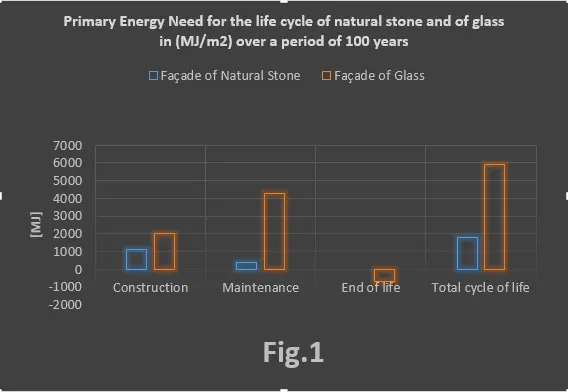
Other environmental facts about glass facades are:
Global warming potential (GWP) – 2.5 times higher
– Ozone-smog potential (POCP) – 4 times higher
– Acidification potential (AP) – 3 times higher
– Ozone depletion potential (ODP) – 1.5 times higher
– Eutrophication potential (EP) – 4 times higher
The next part of the study reveals a considerable environmental benefit of natural stone over the glass. The main energy need of a glass facade is more than twicethat of an equivalent natural stone facade (Figure 2).
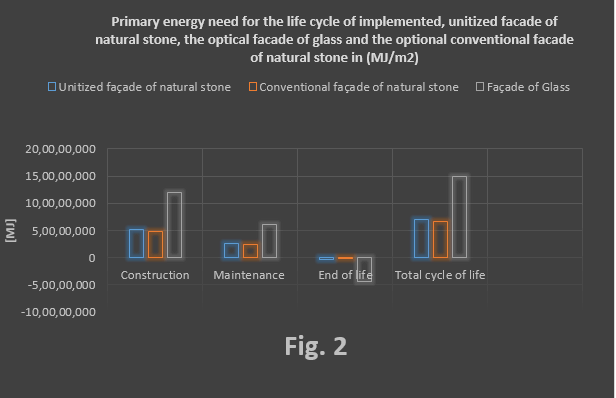
Overall, the ecological effect of glass facades is found to be 60 to 175 % higher than that of a facade made using a natural stone.
Economical benefits of using natural stone
Natural stone outperforms glass façade not only in terms of the environment but is also very reasonable in terms of price. For example, the heat transfer factor for a natural stone facade is 0,32 W/m2, which is quite lower than a glass facade that has a coefficient of 1,25 W/m2. Due to this lower heat conductivity level, the heating/cooling requirements of buildings featuring natural stone facades are markedly lower as well.
Another research done by Darmstadt InstitutWohnen und Umwelt reveals that the energy requirement of a facade of natural stone is expected at between 100 and 150-kilowatt hours per square meter annually [kWh/m²a], while the initial energy consumption of glass façade buildings extents to 300 and 700-kilowatt hours per square meter in a year. ( SOURCE)
Types of Stone Cladding
When it comes to design a steady and elegant cladding using natural stones, it is extremely necessary to take into account the weight and other properties of the stone. According to experts, the weight of the stone is extremely important after all it is about fixing a heavy object to a vertical surface.
The most widely used types of natural stone cladding are:
Handset Cladding
Traditional handset cladding is considered an ancient building construction practice in which natural stone is attached to pre-built support. In general, the natural stone acts as an exterior wrapper for a building.
Rainscreen Method
Under this type of cladding, natural stone panels are connected onto the building face using either a covered system or a visible clip mechanism. Stone-clad rainscreen façades are primarily back-ventilated and include an interior drainage fissure, which helps in the removal of the underlying moisture in the structure.
Custom Cladding
This type of cladding includes the creation of custom stone-clad surfaces that appear like complex mosaics.
Natural Stone Options for Cladding
Different types of natural stones can be used for wall cladding purposes. They are generally divided into three geographical segments – sedimentary rocks such as sandstone, metamorphic rocks such as slate, and eventually, igneous rocks like granite.
When it comes to choosing the best material for cladding purposes, architects and contractors must take into account several factors like projected application, appearance, project scale, and most importantly, the composite that would provide the preferred level of strength and longevity.
Below are the popular natural stones for wall cladding
1. Sandstone
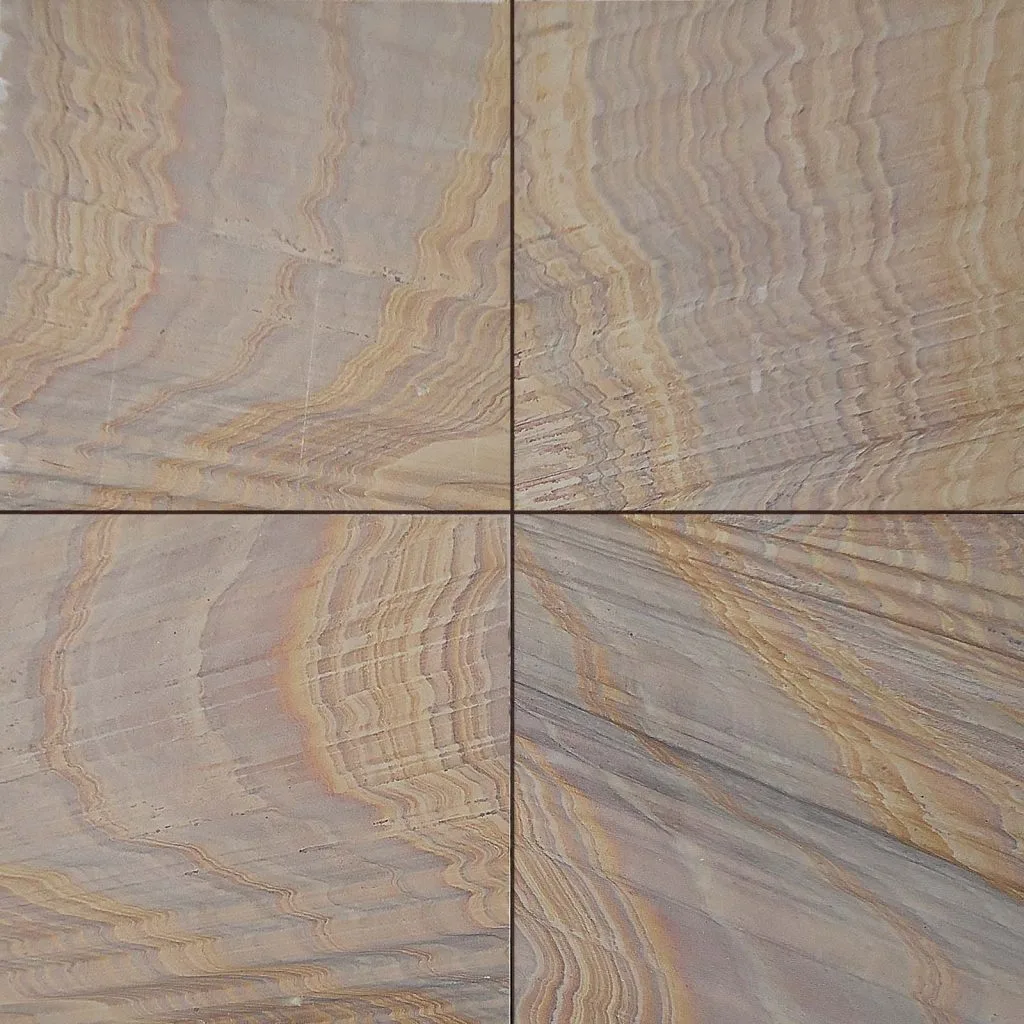
Sandstone is a great option for wall cladding due to its cost-effectiveness. It can be installed on new or existing walls.
The best thing about sandstone is that it comes in a wide variety of hues and patterns which means it can easily gel with the surroundings.
Moreover, it can be used for both exteriors as well as interior applications due to its exceptional level of hardness, durability, and weather-resistance qualities.
2. Quartzite
Known for its amazing hardness and durability, quartzite always remains a preferred choice for cladding purposes.
This natural stone comes in a wide assortment of colors that are caused by minerals subverting the stone during the development process.
With its shades ranging from copper and silver to green, quartzite cladding is the most sought-after way to transform the looks of any construction.
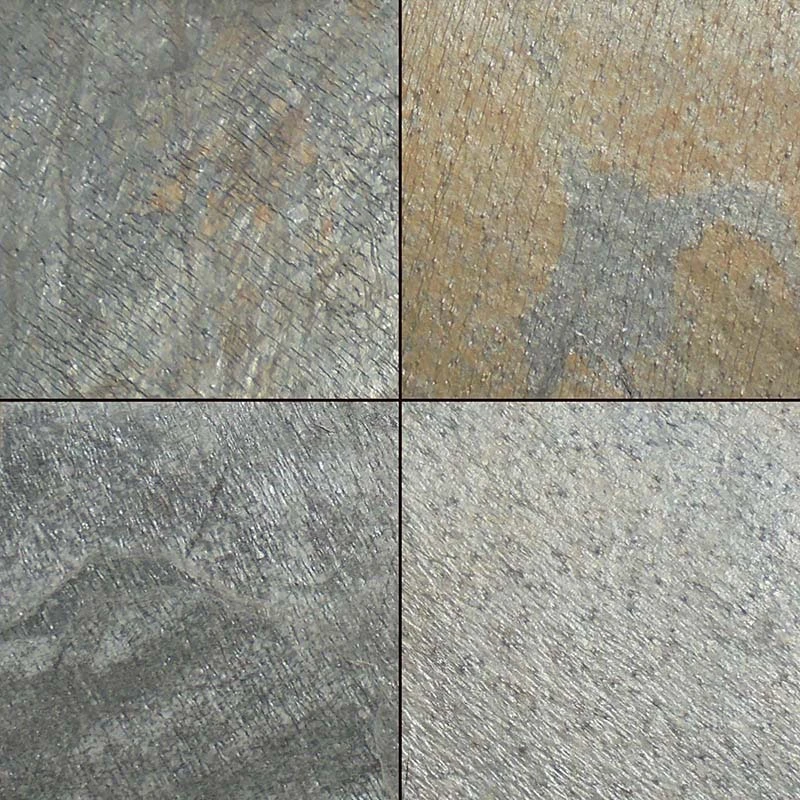
3. Granite
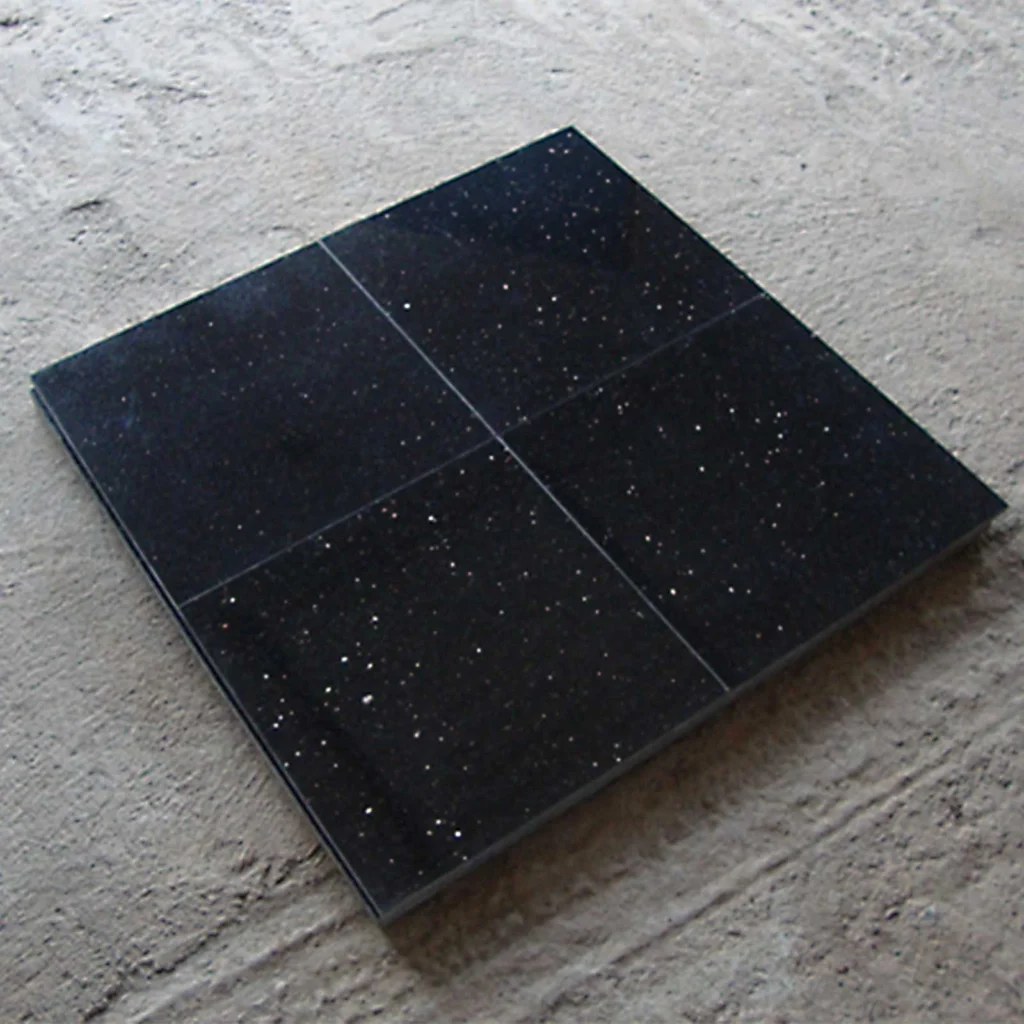
It is a coarse-grained natural stone that is made up of intertwining crystals. It is widely used for wall cladding applications due to its water resistance and thermal insulation properties. Besides, it is highly durable, easy to maintain, and looks awesome which means it possesses all the qualities required for exterior construction applications like wall cladding. From Ivory White to French Green, this stone comes in nearly an endless range of colors. Granite wall cladding performs not only functionally but visually too.
4. Marble
For ages, marble has been widely used for various types of construction. It is a stone that is greatly appreciated for its ability to reflect light, weather resistance, and timeless existence.
Wall cladding done with Indian marble instils a sense of space and creates a stunning background for sculpture and other decorative elements.
Nevertheless, marble stone can be used in different ways to give any wall a distinctive look. Some of the popular patterns are random layout, layered effect, progressive vein-matching, and well-defined portraits.
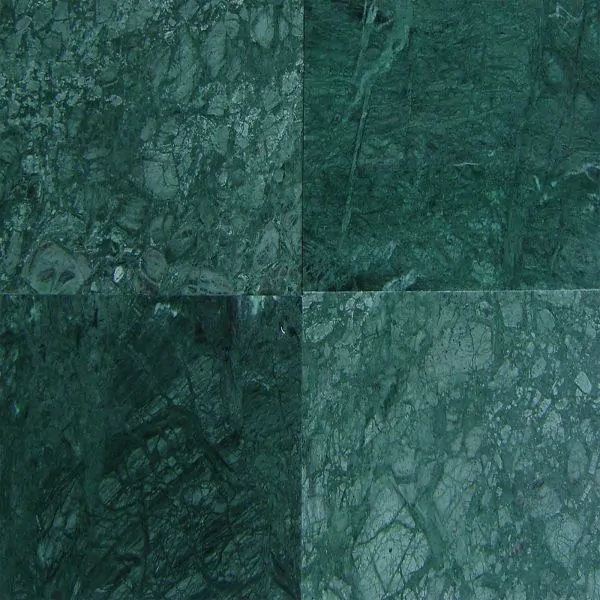
5. Limestone
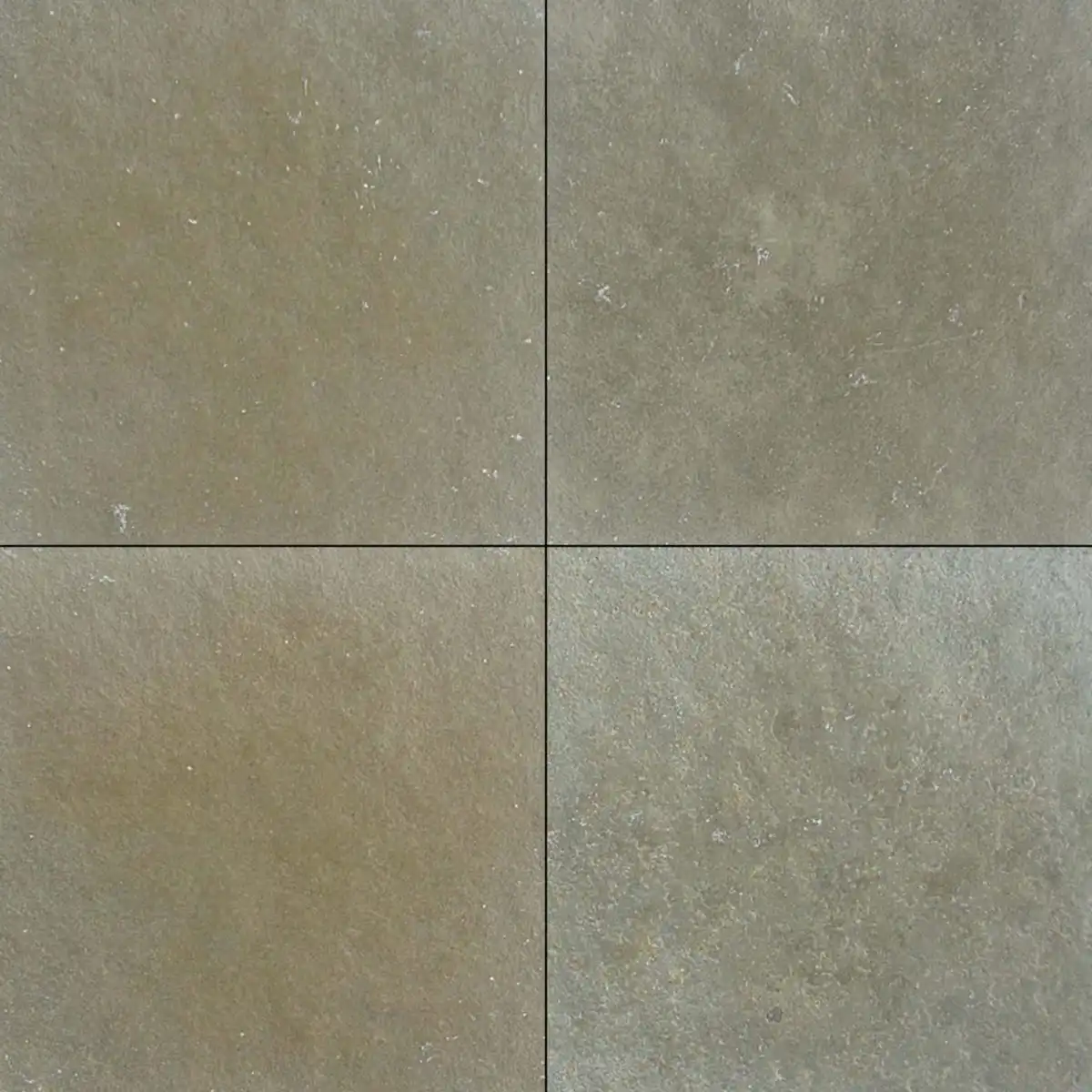
This natural stone can be used on the outer surfaces of hotels, high-rise buildings, homes, shopping complexes, and office buildings. The homogeneity of this stone product makes it a wonderful choice for wall cladding.
Severalultra-modern architectural projects such as theatres, auditoriums, and conference halls have been covered in this stone, specifically in lighter colors.
However, the yellow and pink shades of limestone are also widely treasured among constructors and architects.
6. Slate
Being a metamorphic stone, slate is considered a perfect constructional material for both exterior and interior cladding purposes. Apart from a stylish and sophisticated look, the natural stone features extreme durability, great water resistance, and low maintenance.
As they come in a wide range of colors, architects and interior find it easy to get the perfect match for the surroundings. When it comes to sizing, slate stone can be bought in standard as well as custom sizes as per the project requirements.

Now, let’s look at some examples of natural stone wall cladding below:
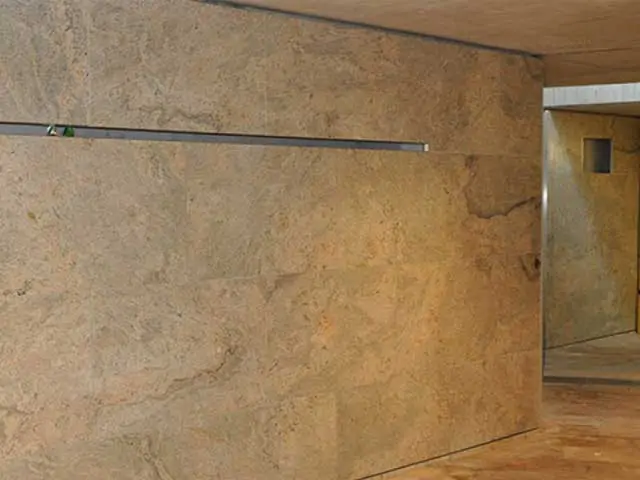

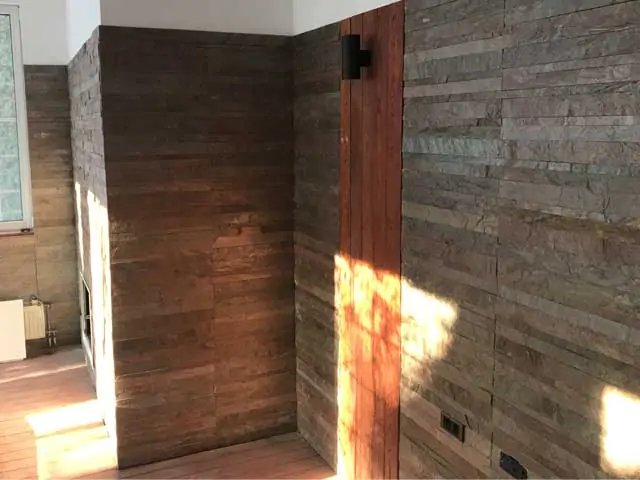
Generally, it can be easily perceived from the above analysis is that natural stone has a natural tendency to support the environment rather than act against it. From energy consumption to thermal insulation and causing ecological damage, wide-ranging choices, and cost-effectiveness, natural stone outperforms glass in almost every aspect.
